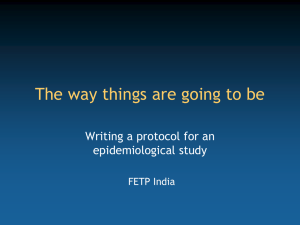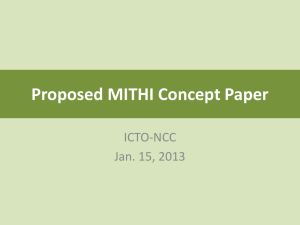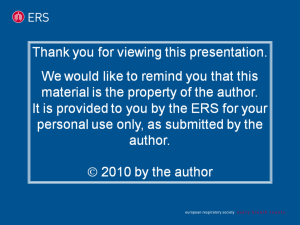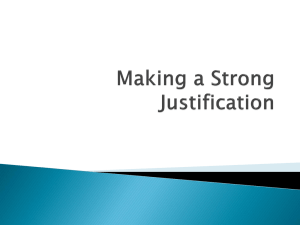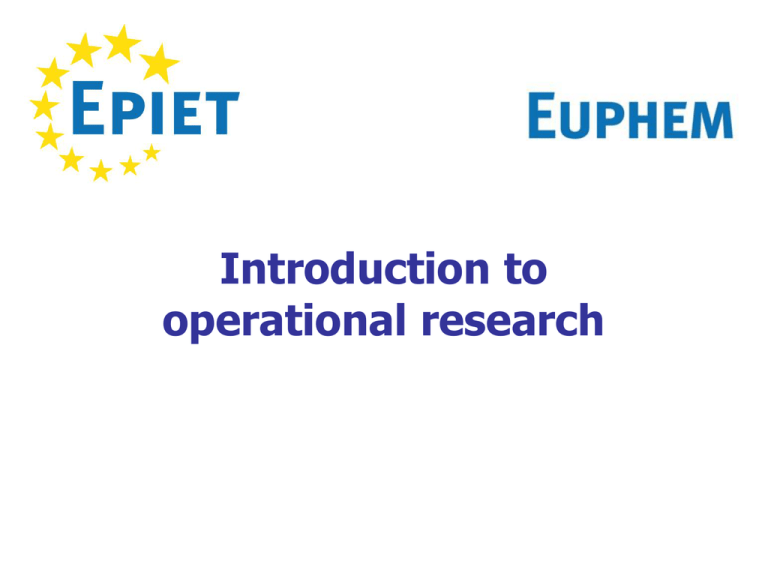
Introduction to
operational research
The life cycle of an epidemiological
investigation
Identifying
data needs
Involving the
programme
Spelling out the
research question
Formulating
recommendations
Formulating the
study objectives
Drawing conclusions
Planning the
analysis
Analysing data
Preparing data
collection instruments
Collecting data
NEJM 2007; 356: 895-903
Example of a life cycle for an
epidemiological investigation
Hepatitis E endemic
in South Asia
How do we use
this vaccine?
Does hepatitis E
vaccine works?
Consider use
of the vaccine
What is the efficacy
of the vaccine?
New
cycle
can
start
Vaccine efficacy: 95%
Vaccine trial
Relative risk
Surveillance
Vaccine cards
Data on vaccination
and disease
The seven steps of a successful protocol
• Identify topic, question and objectives
• Outline a one-page concept paper
• Prepare dummy tables
• Write draft protocol
• Prepare instruments and annexes
• Submit to peer review
• Seek ethical committee clearance
The seven steps of a successful protocol
• Identify topic, question and objectives
• Outline a one-page concept paper
• Prepare dummy tables
• Write draft protocol
• Prepare instruments and annexes
• Submit to peer review
• Seek ethical committee clearance
The life cycle of an epidemiological
investigation
Identifying
data needs
Involving the
programme
Spelling out the
research question
Formulating
recommendations
Formulating the
study objectives
Drawing conclusions
Planning the
analysis
Analysing data
Preparing data
collection instruments
Collecting data
Working with public health managers to
identify data needs
• Identify public health problems
• Estimate public health importance
• Analyze problems
• Review what is being already done
• Identify the information needed to improve
The research question
• Frames the problem in public health terms
• Focuses on one issue
• Uses everyday language
• Can use more than one verb
• Is general
• Links with the action that would be taken
The research question:
Example
We would like to understand why some tuberculosis
patients do not complete their DOTs treatment so
that we could address these issues and improve
completion rate
The study objectives
• Frame the problem in epidemiological terms
• Focus the question
• Are written using epidemiological language
• Make use of no more than one verb each
• May be sorted out as primary and secondary
• Should be clear about whether:
– They call for testing a hypothesis
– They call for measuring a quantity
The study objective:
Example
Compare defaulters and non defaulters in terms of a
number of characteristics that may be associated
with observance among tuberculosis patients treated
with Directly Observed Therapy (DOTs)
The life cycle of an epidemiological
investigation
Identifying
data needs
Involving the
programme
Spelling out the
research question
Formulating
recommendations
Formulating the
study objectives
Drawing conclusions
Planning the
analysis
Analysing data
Preparing data
collection instruments
Collecting data
A malaria drug efficacy study,
Ivory Coast, 1995
• Treatment policy: Chloroquine
• Problem statement: None
– “We want resistance data”
• No hypothesis: No data on clinical outcomes
• Study: Resistance = 10%
• Interpretation: ???
• Recommendation
– Obtain surveillance data (e.g., CFR)
Unclear hypotheses: Difficult interpretation
A malaria drug efficacy study,
North Bengal, India, 2005
• Treatment policy: Chloroquine / primaquine
• Problem statement:
• Increased incidence, anecdotal report of treatment
failures, emergence of Falciparum
• Hypothesis:
• Is chloroquine resistance > 15% threshold (WHO)?
• Study: Resistance = 52%
• Interpretation: Resistance common
• Recommendation: Change first line drug
Clear hypotheses: Easy interpretation
The seven steps of a successful protocol
• Identify topic, question and objectives
• Outline a one-page concept paper
• Prepare dummy tables
• Write draft protocol
• Prepare instruments and annexes
• Submit to peer review
• Seek ethical committee clearance
Outline of the one-page concept paper
• Background and justification
• Objectives
• Methods
• Expected benefits
• Budget
Outline of the one-page concept paper
• Background and justification
– Importance of the problem
– Work done to address it
– Information missing to prevent/ control more effectively
• Objectives
• Methods
• Expected benefits
• Budget
Background and justification:
Example
• In India, anemia is common among adolescent girls,
particularly tribes
• The Government of India supplements adolescent
girls with iron and folic acid in several states, but not
in Madhya Pradesh
• It is unclear whether it is feasible to supplement
tribal adolescent girls with iron and folic acid in
Madhya Pradesh
Outline of the one-page concept paper
• Background and justification
• Objectives
– 2-3 objectives
– Can be general and specific
– Can be primary and secondary
• Methods
• Expected benefits
• Budget
Objectives: Example
• To estimate the prevalence of iron deficiency anemia
among adolescent girls before and after a pilot
supplementation intervention
• To identify the factors associated with coverage
Outline of the one-page concept paper
• Background and justification
• Objectives
• Methods
– Outline of the methods
– One bullet per point
• Expected benefits
• Budget
Outline of the methods
• Study design
• Study population
• Operational definitions
• Sampling procedure
• Sample size
• Data collection
• Analysis plan
• Human subjects protection
Methods:
Design, population, definitions and sample
• Study design
– Pilot intervention with pre and post cross-sectional studies
• Study population
– Adolescent tribal girls aged 12-19 years, Mandla district, MP
• Operational definitions: WHO criteria for anemia
• Sampling procedure: Cluster sample
• Sample size
– Considering 95% confidence interval, 20% error, allowing
20% dropout, expecting a difference of 1g% of hemoglobin
level, a total of 168 adolescent girls will be required
Methods: Data collection
• Field worker will collect data under supervision
• Baseline and post intervention estimation of Hb
– Cyanmethaemoglobin method
• Semi-structure questionnaire
– Demographic characteristics
– Knowledge and socio-cultural practices
Methods: Analysis plan, ethics
• Analysis plan
– Descriptive and multivariate analysis to:
• Estimate the prevalence of anemia before and after
• Identify factors associated with (a) tablet consumption and (b)
anemia in the post intervention phase
• Human subjects protection
– Confidentiality protection
– Written informed consent
– Protocol submitted for ethical clearance
Outline of the one-page concept paper
• Background and justification
• Objectives
• Methods
• Expected benefits
– What action will be taken following results
– Future operational research agenda
• Budget
Expected benefits: Example
• Output
– Documented report shared with local health authorities
• Outcome
– Enable local authorities to implement the programme on a
larger scale after taking cognizance of compliance issues
identified through the study
Outline of the one-page concept paper
• Background and justification
• Objectives
• Methods
• Expected benefits
• Budget
– 4-5 lines
– No detailed justification
– Divided in salaries/per diem, travel, equipment & supply and
miscellaneous
Budget: Example
• Per diem
– USD 1500
• Travel
– USD 1500
• Supplies
– Laboratory reagents, drugs, stationary
– USD 2000
• Total
– USD 5000
The seven steps of a successful protocol
• Identify topic, question and objectives
• Outline a one-page concept paper
• Prepare dummy tables
• Write draft protocol
• Prepare instruments and annexes
• Submit to peer review
• Seek ethical committee clearance
Dummy table for iodine deficiency study
(Analytical stage)
Prevalence
Exposures
Exposed
Unexposed
Prevalence ratio
(95% confidence
interval)
Female sex
XX/XX (XX%)
XX/XX (XX%)
XX (XX-XX)
Muslim
XX/XX (XX%)
XX/XX (XX%)
XX (XX-XX)
Age > 30
XX/XX (XX%)
XX/XX (XX%)
XX (XX-XX)
Below poverty line
XX/XX (XX%)
XX/XX (XX%)
XX (XX-XX)
Schedule caste
XX/XX (XX%)
XX/XX (XX%)
XX (XX-XX)
The seven steps of a successful protocol
• Identify topic, question and objectives
• Outline a one-page concept paper
• Prepare dummy tables
• Write draft protocol
• Prepare instruments and annexes
• Submit to peer review
• Seek ethical committee clearance
The first draft of the protocol
• Thought as it is written
• Uses the concept paper outline
• Keeps concept paper as summary
• Does not exceed 2000 words
– Introduction < 20% of length
• Contains 5 – 10 key references
The outline of the protocol is identical to the
outline of the concept paper
• Background and justification
• Objectives
• Methods
• Expected benefits
• Budget
The outline of the protocol is identical to the
outline of the concept paper
• Background and justification
• Objectives
• Methods
– Require many more additional details
• Expected benefits
• Budget
Outline of the methods
• Study design
• Description of the interventions
• Study population
• Operational definitions
• Sampling procedure
• Sample size
• Data collection
• The analysis plan
• Quality assurance
• Human subjects protection
Quality assurance paragraph
• Details the steps that will be used to ensure data
quality at all stages
• Addresses:
– Protocol writing
– Data collection
– Data entry
– Data analysis
– Reporting
The seven steps of a successful protocol
• Identify topic, question and objectives
• Outline a one-page concept paper
• Prepare dummy tables
• Write draft protocol
• Prepare instruments and annexes
• Submit to peer review
• Seek ethical committee clearance
Data collection instruments
• Present all data collection instruments
• Questionnaires
• Abstraction forms
• Structured observation guides
• Drafts may evolve as the protocol evolves
Annexes
• Procedures
• Training framework for field workers
• Patient recruitment material
• Adverse event management form
• Consent forms
The seven steps of a successful protocol
• Identify topic, question and objectives
• Outline a one-page concept paper
• Prepare dummy tables
• Write draft protocol
• Prepare instruments and annexes
• Submit to peer review
– Obtain feedback
– Ensure quality
– Facilitate ethical committee approval
• Seek ethical committee clearance
The seven steps of a successful protocol
• Identify topic, question and objectives
• Outline a one-page concept paper
• Prepare dummy tables
• Write draft protocol
• Prepare instruments and annexes
• Submit to peer review
• Seek ethical committee clearance
– Protect human subjects
– Document conformity to principles
– Ensure quality
Finalizing a protocol
• Disseminate
• Keep and use for reference
• Use for report writing
• Archive
Take home messages
• Always start with a concept paper
• Unfold the protocol logically from the objectives
• Revise, revise and revise
Additional resources on protocol writing
• Concept paper:
– Example
– Template
• Case study on protocol writing (Scrub Typhus in
Darjeeling, Volume 2)
• Template protocol
• Guide to common errors in protocols (with checklist)
• Dummy tables for field epidemiology

